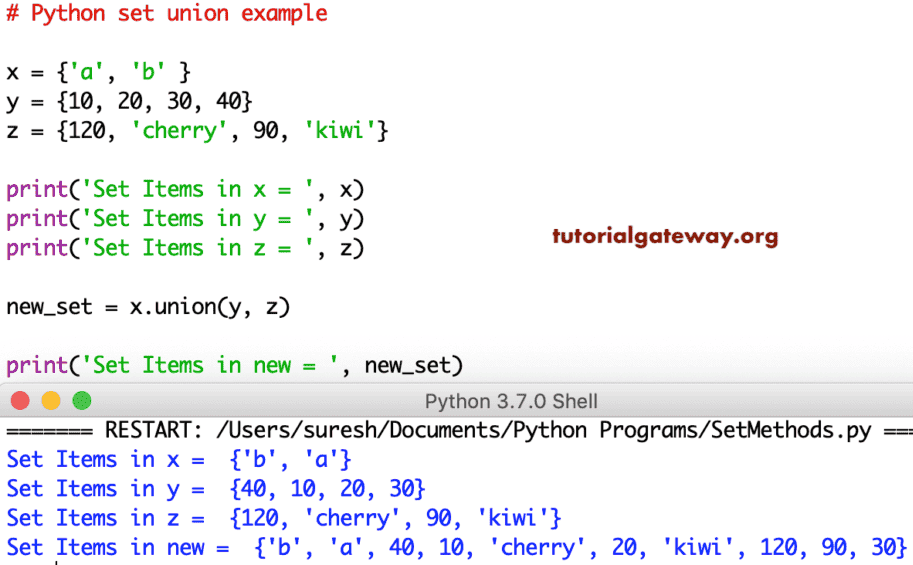Python 的 union 函数将原始集合和指定的集合中的所有元素合并,其语法如下:
set.union(set1, set2,…,setN)
Python 集合并集示例
在此示例中,我们声明了两个集合,然后使用 union 方法将它们合并。
x = {'a', 'b', 'c', 'd'}
y = {'e', 'f', 'g', 'h'}
print('Items in x = ', x)
print('Items in y = ', y)
z = x.union(y)
print('Items in z = ', z)
Items in x = {'c', 'd', 'b', 'a'}
Items in y = {'f', 'h', 'e', 'g'}
Items in z = {'f', 'h', 'd', 'g', 'c', 'b', 'a', 'e'}集合不允许包含重复值。因此,使用 union 方法合并两个集合会删除重复值。如果您观察输出,a 和 c 只返回了一次(尽管它们同时存在于 x 和 y 中)。
提示:请参考 Programming 中的 Python 集合。
x = {'a', 'b', 'c', 'd'}
y = {'a', 'f', 'g', 'c', 'h', 'j', 'k'}
print('x = ', x)
print('y = ', y)
z = x.union(y)
print('z = ', z)
x = {'b', 'a', 'c', 'd'}
y = {'k', 'j', 'g', 'a', 'c', 'h', 'f'}
z = {'b', 'k', 'a', 'd', 'j', 'g', 'c', 'h', 'f'}集合并集函数 示例 2
我将使用三个集合与 union 函数。此示例合并了所有三个集合。它首先合并 x 中的元素,然后合并 y 和 z 中的元素。
x = {'a', 'b' }
y = {'e', 'f', 'g', 'h'}
z = {'apple', 'cherry', 'kiwi'}
print('Items in x = ', x)
print('Items in y = ', y)
print('Items in z = ', z)
new = x.union(y, z)
print('Items in new = ', new)
Items in x = {'a', 'b'}
Items in y = {'h', 'g', 'e', 'f'}
Items in z = {'kiwi', 'apple', 'cherry'}
Items in new = {'kiwi', 'g', 'h', 'apple', 'e', 'a', 'f', 'b', 'cherry'}
此示例演示了如何合并数字和字符串。
x = {'a', 'b' }
y = {10, 20, 30, 40}
print('Items in x = ', x)
print('Items in y = ', y)
z = x.union(y)
print('Items in z = ', z)
合并数字和字符串输出
Items in x = {'b', 'a'}
Items in y = {40, 10, 20, 30}
Items in z = {20, 'b', 40, 10, 30, 'a'}在这里,我们声明了一个数字集合、一个字符串集合和一个混合集合。接下来,我们使用该方法将它们全部合并并返回一个新的集合。
x = {'a', 'b' }
y = {10, 20, 30, 40}
z = {120, 'cherry', 90, 'kiwi'}
print('Set Items in x = ', x)
print('Set Items in y = ', y)
print('Set Items in z = ', z)
new_set = x.union(y, z)
print('Set Items in new = ', new_set)
